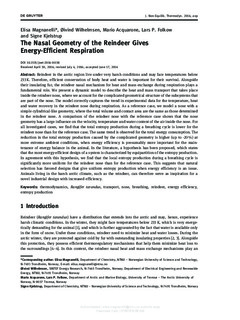The Nasal Geometry of the Reindeer Gives Energy-Efficient Respiration
Journal article, Peer reviewed
Permanent lenke
http://hdl.handle.net/11250/2434639Utgivelsesdato
2016Metadata
Vis full innførselSamlinger
- Institutt for energi og prosessteknikk [4200]
- Institutt for kjemi [1391]
- Publikasjoner fra CRIStin - NTNU [38069]
Sammendrag
Reindeer in the arctic region live under very harsh conditions and may face temperatures below 233 K. Therefore, efficient conservation of body heat and water is important for their survival. Alongside their insulating fur, the reindeer nasal mechanism for heat and mass exchange during respiration plays a fundamental role. We present a dynamic model to describe the heat and mass transport that takes place inside the reindeer nose, where we account for the complicated geometrical structure of the subsystems that are part of the nose. The model correctly captures the trend in experimental data for the temperature, heat and water recovery in the reindeer nose during respiration. As a reference case, we model a nose with a simple cylindrical-like geometry, where the total volume and contact area are the same as those determined in the reindeer nose. A comparison of the reindeer nose with the reference case shows that the nose geometry has a large influence on the velocity, temperature and water content of the air inside the nose. For all investigated cases, we find that the total entropy production during a breathing cycle is lower for the reindeer nose than for the reference case. The same trend is observed for the total energy consumption. The reduction in the total entropy production caused by the complicated geometry is higher (up to -20 %) at more extreme ambient conditions, when energy efficiency is presumably more important for the maintenance of energy balance in the animal. In the literature, a hypothesis has been proposed, which states that the most energy-efficient design of a system is characterized by equipartition of the entropy production. In agreement with this hypothesis, we find that the local entropy production during a breathing cycle is significantly more uniform for the reindeer nose than for the reference case. This suggests that natural selection has favored designs that give uniform entropy production when energy efficiency is an issue. Animals living in the harsh arctic climate, such as the reindeer, can therefore serve as inspiration for a novel industrial design with increased efficiency.
